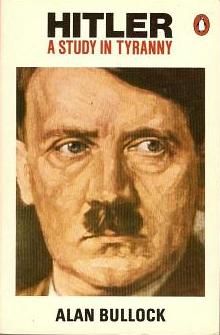Adolf Hitler (1889–1945) was the leader of Nazi Germany from 1933 to 1945.
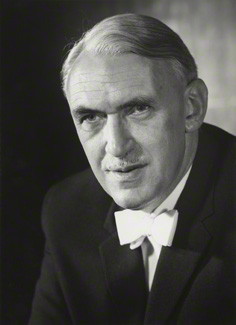
Alan Louis Charles Bullock, Baron Bullock, was a British historian. He is best known for his book Hitler: A Study in Tyranny (1952), the first comprehensive biography of Adolf Hitler, which influenced many other Hitler biographies.

Angela Maria "Geli" Raubal was an Austrian woman who was the half-niece of Adolf Hitler. Born in Linz, Austria-Hungary, she was the second child and eldest daughter of Leo Raubal Sr. and Hitler's half-sister, Angela Raubal. Raubal lived in close contact with her half-uncle Adolf from 1925 until her presumed suicide in 1931.
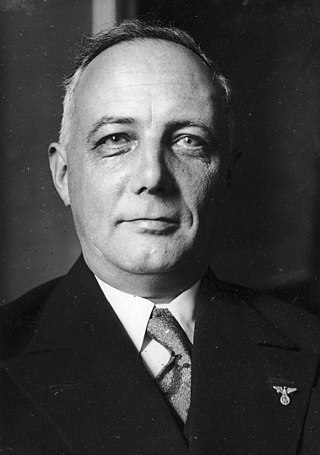
Hermann Adolf Reinhold Rauschning was a German politician and author, adherent of the Conservative Revolution movement who briefly joined the Nazi movement before breaking with it. He was the President of the Senate of the Free City of Danzig from 1933 to 1934. In 1934, he renounced Nazi Party membership and in 1936 emigrated from Germany. He eventually settled in the United States and began openly denouncing Nazism. Rauschning is chiefly known for his book Gespräche mit Hitler in which he claimed to have had many meetings and conversations with Adolf Hitler.

The political views of Adolf Hitler, dictator of Germany from 1933 to 1945, have presented historians and biographers with some difficulty. Hitler's writings and methods were often adapted to need and circumstance, although there were some steady themes, including antisemitism, anti-communism, anti-slavism, anti-parliamentarianism, German Lebensraum, belief in the superiority of an "Aryan race" and an extreme form of German nationalism. Hitler personally claimed he was fighting against "Jewish Marxism" and "international Jewish finance".

Blondi was Adolf Hitler's German Shepherd, a gift as a puppy from Martin Bormann in 1941. Hitler kept Blondi even after his move into the Führerbunker located underneath the garden of the Reich Chancellery on 16 January 1945.

Heinrich Hoffmann was Adolf Hitler's official photographer, and a Nazi politician and publisher, who was a member of Hitler's intimate circle. Hoffmann's photographs were a significant part of Hitler's propaganda campaign to present himself and the Nazi Party as a significant mass phenomenon. He received royalties from all uses of Hitler's image, which made him a millionaire over the course of Hitler's rule. After the Second World War he was tried and sentenced to 10 years in prison for war profiteering. He was classified by the Allies' Art Looting Investigators to be a "major offender" in Nazi art plundering of Jews, as both art dealer and collector and his art collection, which contained many artworks looted from Jews, was ordered confiscated by the Allies.

Adolf Hitler was an Austrian-born German politician who was the dictator of Nazi Germany from 1933 until his suicide in 1945. He rose to power as the leader of the Nazi Party, becoming the chancellor in 1933 and then taking the title of Führer und Reichskanzler in 1934. His invasion of Poland on 1 September 1939 marked the start of the Second World War. He was closely involved in military operations throughout the war and was central to the perpetration of the Holocaust: the genocide of about six million Jews and millions of other victims.

This bibliography of Adolf Hitler is a list of some non-fiction texts in English written about and by him.
Nazi Germany was an overwhelmingly Christian nation. A census in May 1939, six years into the Nazi era and a year following the annexations of Austria and Czechoslovakia into Germany, indicates that 54% of the population considered itself Protestant, 41% considered itself Catholic, 3.5% self-identified as Gottgläubig, and 1.5% as "atheist". Protestants were over-represented in the Nazi Party's membership and electorate, and Catholics were under-represented.

Ulrich Graf was an early member of the Nazi Party and one of Adolf Hitler's inner circle. In 1923, he served in a bodyguard unit for Hitler and was wounded in the Beer Hall Putsch. Graf was considered a lifesaver for Hitler, using himself as human shield and taking five bullets for him. He was a long serving member of the Munich City Council and the Supreme Party Court and in 1936 was elected to the Reichstag. After the war, Graf was sentenced to five years of hard labour by a denazification court and died in 1950.
The religious beliefs of Adolf Hitler, dictator of Nazi Germany from 1933 to 1945, have been a matter of debate. His opinions regarding religious matters changed considerably over time. During the beginning of his political career, Hitler publicly expressed favorable opinions towards traditional Christian ideals, but later abandoned them. Most historians describe his later posture as adversarial to organized Christianity and established Christian denominations. He also staunchly criticized atheism.
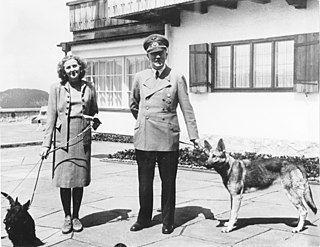
The sexuality of Adolf Hitler, dictator of Nazi Germany from 1933 to 1945, has long been a matter of historical and scholarly debate, as well as speculation and rumour. There is evidence that he had relationships with a number of women during his lifetime, as well as evidence of his antipathy to homosexuality, and no evidence of homosexual encounters. His name has been linked to a number of possible female lovers, two of whom committed suicide. A third died of complications eight years after a suicide attempt, and a fourth also attempted suicide.
Historians, political scientists and philosophers have studied Nazism with a specific focus on its religious and pseudo-religious aspects. It has been debated whether Nazism would constitute a political religion, and there has also been research on the millenarian, messianic, and occult or esoteric aspects of Nazism.
The Hitler family comprises the relatives and ancestors of Adolf Hitler, an Austrian-born German politician and the leader of the Nazi Party, who was the dictator of Germany, holding the title Chancellor of Germany from 1933 to 1945, and head of state as Führer und Reichskanzler from 1934 to 1945. Adolf Hitler had a central role in the rise of Nazism in Germany, provoking the start of World War II, and holding ultimate responsibility for the deaths of many millions of people during the Holocaust.

Various historians and other authors have carried out a comparison of Nazism and Stalinism, with particular consideration to the similarities and differences between the two ideologies and political systems, the relationship between the two regimes, and why both came to prominence simultaneously. During the 20th century, comparisons of Nazism and Stalinism were made on totalitarianism, ideology, and personality cult. Both regimes were seen in contrast to the liberal democratic Western world, emphasising the similarities between the two.

Hitler and Stalin: Parallel Lives is a 1991 book by the historian Alan Bullock, in which the author puts the German dictator Adolf Hitler in perspective with the Soviet dictator Joseph Stalin.

Nazi ideology could not accept an autonomous establishment whose legitimacy did not spring from the government. It desired the subordination of the church to the state. To many Nazis, Catholics were suspected of insufficient patriotism, or even of disloyalty to the Fatherland, and of serving the interests of "sinister alien forces". Nazi radicals also disdained the Semitic origins of Jesus and the Christian religion. Although the broader membership of the Nazi Party after 1933 came to include many Catholics, aggressive anti-church radicals like Alfred Rosenberg, Martin Bormann, and Heinrich Himmler saw the kirchenkampf campaign against the churches as a priority concern, and anti-church and anti-clerical sentiments were strong among grassroots party activists.
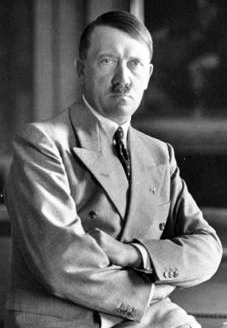
The historiography of Adolf Hitler deals with the academic studies of Adolf Hitler from the 1930s to the present. In 1998, a German editor said there were 120,000 studies of Hitler and Nazi Germany. Since then many more have appeared, with many of them decisively shaping the historiography regarding Hitler.

Adolf Hitler's cult of personality was a prominent feature of Nazi Germany (1933–1945), which began in the 1920s during the early days of the Nazi Party. Based on the Führerprinzip ideology, that the leader is always right, spread by incessant Nazi propaganda, and reinforced by Adolf Hitler's success in fixing Germany's economic and unemployment problems by remilitarising during the global Great Depression, his bloodless triumphs in foreign policy prior to World War II, and the rapid military defeat of the Second Polish Republic and the French Third Republic in the early part of the war, it eventually became a central aspect of the Nazi control over the German people.
